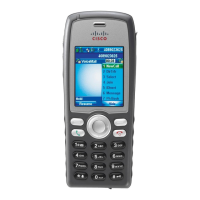ExplanationSummary
An unstable RF environment can cause the phone to remain in active mode
because it is constantly seeking an AP. This reduces the battery life
considerably. When leaving an area of coverage, shut down the phone.
Higher phone transmit power can affect battery life.
To maximize idle time on the phone and conserve battery life, you need
to optimize the registration time so the phone can go into power save mode
more often.
Battery life is shorter than
specified
The phone does not have a DHCP IP address, is unable to register to Cisco
Unified Communications Manager, and shows a Configuring IP or
Registering message.
Verify the following:
1
The Cisco Unified Communications Manager service is running on
the Cisco Unified Communications Manager server.
2
Both phones are registered to the same Cisco Unified Communications
Manager.
3
Audio server debug and capture logs are enabled for both phones. If
needed, enable Java debug.
Phone call cannot be established
Call statistics display does not show iLBC as the receiver/sender codec.
1
Check the following using the Cisco Unified Communications Manager
administration pages:
•
Both phones are in the iLBC device pool.
•
The iLBC device pool is configured with the iLBC region.
•
The iLBC region is configured with the iLBC codec.
2
Capture a sniffer trace between the phone and Cisco Unified
Communications Manager and verify that SCCP
messages,OpenReceiveChannel, and StationMediaTransmit messages
have media payload type value equal to 86. If so, the problem is with
the phone; otherwise the problem is with the Cisco Unified
Communications Manager configuration.
3
Enable audio server debug and capture logs from both phones. If
needed, enable Java debug.
Call established with the iLBC
protocol does not show that the
iLBC codec is being used
For additional troubleshooting information, see the Cisco Unified Communications Manager Troubleshooting
Guide.
Related Topics
Common Phone Status Messages, on page 223
Cisco Unified Wireless IP Phone 7925G, 7925G-EX, and 7926G Administration Guide
226
Troubleshooting
General Troubleshooting Information

